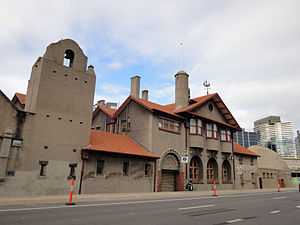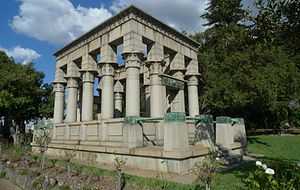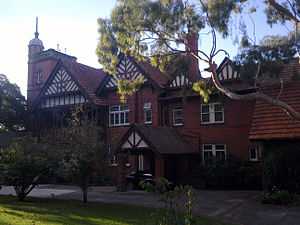Walter Butler (architect)
| Professor Walter Richmond Butler | |
|---|---|
| Born |
24 March 1864 Somerset, England |
| Died | 31 May 1949 (aged 85) |
| Occupation | Architect |
Walter Richmond Butler (24 March 1864 – 31 May 1949), was an Australian architect trained in the Arts and Crafts style, born in Somerset, England.
Personal life
In 1864 Walter Richmond Butler was born on his family’s farm in Pensford in Somerset, England. He was the sixth of eight children. At 15 Butler became the apprentice of developing Arts and Crafts architect Alexander Lauder (1836–1921), who allegedly described Butler as "a truly gifted person".
Butler frequently travelled throughought England and Europe and it was not until 1888 that Butler decided to follow in the footsteps of five of his siblings and emigrate to Australia in search of prosperity and exciting new possibilities. He departed from Plymouth on the SS Oroya on 21 July arriving in Sydney in October, and by the end of the year had moved to Melbourne.
Butler married Emelie Millicent Howard in April 1894, and they had three children: Adna Millicent Howard, Howard Richmond Henry and Winifred Howard. The family lived in Armadale in the eastern suburbs of Melbournein a large house called Duncraig. Butler’s daughter Adna once described him as "a very energetic man… never idle. He was good at all ball games… and was as fond of dancing and playing bridge as he was of mending anything".
At the age of 21, Butler’s son Howard died fighting in WWI, and it was after this that Butler appeared to limit his professional involvement in architecture. He did however continue as a practicing architect until he retired in 1939 at the age of 75. He died in 1949 at the age of 84.
Professional Life
Having trained with Alexander Lauder in Barnstaple UK, Butler worked for three years in the office of J D Sedding in London where he was accepted into the domestic revival groups centered on William Lethaby, Ernest Gimson and a number of other architects around Richard Norman Shaw and William Morris. In 1885 W. R. Lethaby encouraged Butler to move to London and work with J. D. Sedding, there, he worked for 3 years. In June 1888 Butler left Sedding's firm and set for Australia, where he resided and worked in Melbourne. Three of Butler's brothers and one of his sisters also settled in Australia. From 1889 until 1893 Butler worked in collaboration with Beverely Ussher. In 1896 George C. Inskip joined his practice, however their association ended in 1905 after a disagreement with the Royal Victorian Institute of Architects over the conduct of a competition. In 1907-16 he partnered Ernest R. Bradshaw and after World War I he was in association with his nephew Richard (b. 1892) as W. & R. Butler, which shortly included Marcus Martin. In the late 1930s Butler was in partnership with Hugh Pettit before retiring when Pettit enlisted for World War II.
Notable Projects

The Missions to Seamen (1916)
In 1916 Walter Butler designed the Anglican mission building located on 717 Flinders Street Docklands. It was designed in a mixture of styles one being in the style of Spanish mission revival, which was prevalent during the 1890s, and his immense experience in the arts and craft architecture. What made The Missions to Seamen building so significant was the introduction of the Spanish Mission style to Melbourne. The revival of this building is evident in its bell tower with its pinnacles, its rough-hewn timber trusses, and the monastic- like courtyard. This style soon after became popular in the Melbourne suburbs.[1]

David Syme Tomb (1908)
Walter Butler was selected to carry out the commissioning of this tomb situated in Boroondara Cemetery in Kew. The tomb was designed similarly to an [[Egyptian temple]], only smaller and encompassing a similar symbolic context. Butler ensured that the symbolism best represented Symes character merged with his growing interest in iconography architecture.[2]

Edzell Mansion (1892)
Located in Toorak along the Southbank of the Yarra River, the Edzell mansion can be said to be one of Tooraks grandest mansions. It was originally designed by the architects Reed Smart and Tappin and in 1917 Butler designed extensions to the mansion including a ballroom and an additional garden to the property. What makes this mansion so significant is the mixture of architectural styles by prominent architects.[3]
Other projects[4]
Houses/Mansions
- Blackwood (1891) near Penshurst for R.B. Richie
- Wangarella (1894) in NSW for Thomas Milear
- Newminster Park (1901) near Camperdown for A.S. Chirnside
- Warrawee (1906) in Toorak for A. Rutter Clark
- Thanes (1907) in Kooyong for F.Wallach
- Kamillaroi (1907) for Clive Baillieu
Churches
- Bishopscourt (Extensions) (1902) in East Melbourne
- St Albans (1899) in Armadale
- Wangaratta Cathedral (1907)
- Christ Church (c.1910) in Benalla
City Buildings
- Collins House (1910)
- Queensland Insurance Building[5](1911)
References
- ↑ Victorian Heritage database, http://vhd.heritage.vic.gov.au/vhd/heritage#detail_places;756''
- ↑ Edquist, He who sleeps in Philae: Walter Butler’s tomb for David Syme at Kew, Fabrications, Vol 13, no 1, June 2003.
- ↑ Edzell: On my doorstep, http://www.onmydoorstep.com.au/heritage-listing/1167/edzell
- ↑ Australian Dictionary online, http://adbonline.anu.edu.au/biogs/A070514b.htm''
- ↑ Queensland Insurance Oldies, http://queenslandinsuranceoldies.org/qibuilding.html''